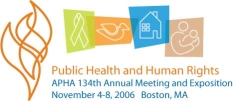 Back to Annual Meeting
|

|
 Back to Annual Meeting
|
APHA Scientific Session and Event Listing |
 Back to Annual Meeting
|

|
 Back to Annual Meeting
|
APHA Scientific Session and Event Listing |
Yu Kang, MPA, UMBC, Department of Public Policy, Public Policy Building, room 415, 1000 Hilltop Circle, Baltimore, MD 21250, 4104553889, yukang1@umbc.edu and Nancy A. Miller, PhD, Public Policy, University of Maryland Baltimore County, 1000 Hilltop Circle, Pub Pol Bldg., Baltimore, MD 21250.
Background: Working age individuals are an increasing share of the nursing home population. Little is known about this population relative to older nursing home residents. Objective: We compare the characteristics of “short” and “long” stay residents by age. Data and Methods: Data from the 1999 National Nursing Home Survey are used. Descriptive methods are used to compare the study groups of interest. Findings: Compared with older individuals (65 years or older), more than half of the younger individuals are male. The share of females does increase among the long –stay population, increasing to 65% for those residing 3 or more years in a nursing home. In general, about one-fifth (21.2%) of discharged younger individuals are married, but among the long-stay individuals, only 15.7% percent are married. While 40 % of long stay younger residents were never married, 15.5% of older long stay residents were never married. Both short and long stay younger residents were more likely to have entered from a hospital, relative to older residents. Most working age individuals were insured through Medicaid. Medicare was a more frequent insurance source for older individuals. Functional limitations were higher among long stay working age individuals as well as older individuals, relative to short stay working age individuals. Implications: In light of the Olmstead decision and subsequent policy initiatives, these findings have implications for identifying and assisting nursing home transitions for younger and older individuals.
Learning Objectives:
Keywords: Long-Term Care, Community-Based Care
Awards: Retirement Research Foundation Masters Student Award - Honorable Mention
Presenting author's disclosure statement:
Not Answered
The 134th Annual Meeting & Exposition (November 4-8, 2006) of APHA